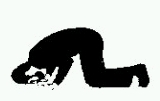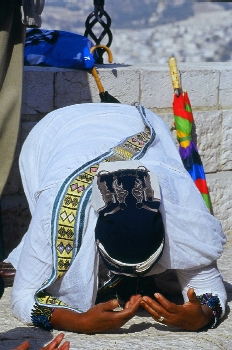Difference between revisions of "Partial Prostration: getting down on hands and knees and face (קידה), Hebrew Qidah, Arabic Sajda"
(Created page with '==References== <references /> Category: Islam and Judaism Category:Prayer Positions') |
|||
| Line 1: | Line 1: | ||
| + | [[Image:Prayer Positions 7.jpg|thumb|Getting down on hands and knees and face]] Qidah – “which means to bow upon the face." I Kings 1:31 (Tractate Berachot 34b). It always implies the face (nose) to the ground and as such, it is forbidden to do on a stone floor outside of the temple. In all the verse of the Torah where ''Qidah'' is mentioned, it is is not combined with ''nefilah apayim'' because that would be redundant. | ||
| + | |||
| + | The position is probably also the posture described in I Kings, xviii. 42, where Elijah at prayer is represented as having "cast himself down upon the earth, and put his face between his knees" (compare Ta'anit 3:8). Other optional forms are mentioned are נשיקה kissing the floor of the Temple (Sukkut 53a,). | ||
| + | |||
| + | Talmud Berakoth 28b says: | ||
| + | |||
| + | :R. Tanhum also said in the name of R. Joshua b. Levi: In saying the Tefillah one should bow down [at the appropriate places] until all the vertebrae in the spinal column are loosened. 'Ulla says: Until an issar16 of flesh is visible opposite his heart.17 R. Hanina said: If he simply bows his head, he need do no more. Said Raba: This is only if it hurts him [to stoop] and he shows that he would like to bow down. | ||
| + | |||
| + | [[Image:Prayer Positions 8.jpg|thumb|Ethiopian Jews during the holiday of 'Sigd']] Given that modern Rabbinic tradition bends the knees and bows at the waist, it is probably to interpret that this nominal prostration is a form of Qida, and that if the Temple were in existence that Qida would be performed today. The Rabbinic nominal “Qida” shares with its Islamic counterpart the requirement that one should preferably bow until "one bends all of one's vertebrae" like a bow. (Mishneh Torah, Hilchos Tefilah 5:12), | ||
| + | |||
| + | Ethiopian Jews are known to prostrate at times, especially during their holiday known as 'Sigd,' which itself means prostration in Amharic, Aramaic, and Arabic. See picture at right: | ||
| + | |||
==References== | ==References== | ||
<references /> | <references /> | ||
Latest revision as of 08:05, 25 May 2010
Qidah – “which means to bow upon the face." I Kings 1:31 (Tractate Berachot 34b). It always implies the face (nose) to the ground and as such, it is forbidden to do on a stone floor outside of the temple. In all the verse of the Torah where Qidah is mentioned, it is is not combined with nefilah apayim because that would be redundant.The position is probably also the posture described in I Kings, xviii. 42, where Elijah at prayer is represented as having "cast himself down upon the earth, and put his face between his knees" (compare Ta'anit 3:8). Other optional forms are mentioned are נשיקה kissing the floor of the Temple (Sukkut 53a,).
Talmud Berakoth 28b says:
- R. Tanhum also said in the name of R. Joshua b. Levi: In saying the Tefillah one should bow down [at the appropriate places] until all the vertebrae in the spinal column are loosened. 'Ulla says: Until an issar16 of flesh is visible opposite his heart.17 R. Hanina said: If he simply bows his head, he need do no more. Said Raba: This is only if it hurts him [to stoop] and he shows that he would like to bow down.
Ethiopian Jews are known to prostrate at times, especially during their holiday known as 'Sigd,' which itself means prostration in Amharic, Aramaic, and Arabic. See picture at right:

